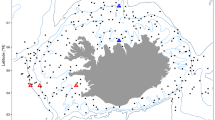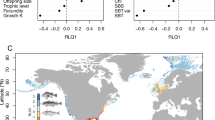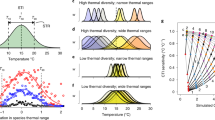Abstract
European continental shelf seas have experienced intense warming over the past 30 years1. In the North Sea, fish have been comprehensively monitored throughout this period and resulting data provide a unique record of changes in distribution and abundance in response to climate change2,3. We use these data to demonstrate the remarkable power of generalized additive models (GAMs), trained on data earlier in the time series, to reliably predict trends in distribution and abundance in later years. Then, challenging process-based models that predict substantial and ongoing poleward shifts of cold-water species4,5, we find that GAMs coupled with climate projections predict future distributions of demersal (bottom-dwelling) fish species over the next 50 years will be strongly constrained by availability of habitat of suitable depth. This will lead to pronounced changes in community structure, species interactions and commercial fisheries, unless individual acclimation or population-level evolutionary adaptations enable fish to tolerate warmer conditions or move to previously uninhabitable locations.
This is a preview of subscription content, access via your institution
Access options
Subscribe to this journal
Receive 12 print issues and online access
$209.00 per year
only $17.42 per issue
Buy this article
- Purchase on Springer Link
- Instant access to full article PDF
Prices may be subject to local taxes which are calculated during checkout



Similar content being viewed by others
References
Sherman, K. & Hempel, G. (eds) UNEP Regional Seas Report and Studies No. 182 (United Nations Environment Programme, 2009).
Perry, A. L., Low, P. J., Ellis, J. R. & Reynolds, J. D. Climate change and distribution shifts in marine fishes. Science 308, 1912–1915 (2005).
Simpson, S. D. et al. Continental shelf-wide response of a fish assemblage to rapid warming of the sea. Curr. Biol. 21, 1565–1570 (2011).
Cheung, W. W. et al. Projecting global marine biodiversity impacts under climate change scenarios. Fish Fish. 10, 235–251 (2009).
Jones, M. C. et al. Predicting the impact of climate change on threatened species in UK waters. PLoS ONE 8, e54216 (2013).
Smith, T. M., Reynolds, R. W., Peterson, T. C. & Lawrimore, J. Improvements to NOAA’s historical merged land–ocean surface temperature analysis (1880–2006). J. Clim. 21, 2283–2296 (2008).
Beaugrand, G., Reid, P. C., Ibanez, F., Lindley, J. A. & Edwards, M. Reorganization of North Atlantic marine copepod biodiversity and climate. Science 296, 1692–1694 (2002).
Edwards, M. & Richardson, A. J. Impact of climate change on marine pelagic phenology and trophic mismatch. Nature 430, 881–884 (2004).
Genner, M. J. et al. Temperature-driven phenological changes within a marine larval fish assemblage. J. Plankton Res. 32, 699–708 (2010).
Beaugrand, G., Brander, K. M., Lindley, J. A., Souissi, S. & Reid, P. C. Plankton effect on cod recruitment in the North Sea. Nature 426, 661–664 (2003).
Durant, J. M., Hjermann, D. O., Ottersen, G. & Stenseth, N. C. Climate and the match or mismatch between predator requirements and resource availability. Clim. Res. 33, 271–283 (2007).
Beare, D. J. et al. Long-term increases in prevalence of North Sea fishes having southern biogeographic affinities. Mar. Ecol. Prog. Ser. 284, 269–278 (2004).
Dulvy, N. K. et al. Climate change and deepening of the North Sea fish assemblage: A biotic indicator of warming seas. J. Appl. Ecol. 45, 1029–1039 (2008).
Cheung, W. W. L., Watson, R. & Pauly, D. Signature of ocean warming in global fisheries catch. Nature 497, 365–369 (2013).
Araujo, M. B., Pearson, R. G., Thuiller, W. & Erhard, M. Validation of species–climate impact models under climate change. Glob. Change Biol. 11, 1504–1513 (2005).
Cheung, W. W. L. et al. Large-scale redistribution of maximum fisheries catch potential in the global ocean under climate change. Glob. Change Biol. 16, 24–35 (2010).
de Madron, X. D. et al. Marine ecosystems’ responses to climatic and anthropogenic forcings in the Mediterranean. Prog. Oceanogr. 91, 97–166 (2011).
Dingsor, G. E., Ciannelli, L., Chan, K-S., Ottersen, G. & Stenseth, N. C. Density dependence and density independence during the early life stages of four marine fish stocks. Ecology 88, 625–634 (2007).
Hedger, R. et al. Analysis of the spatial distributions of mature cod (Gadus morhua) and haddock (Melanogrammus aeglefinus) abundance in the North Sea (1980–1999) using generalised additive models. Fish. Res. 70, 17–25 (2004).
Belanger, C. L. et al. Global environmental predictors of benthic marine biogeographic structure. Proc. Natl Acad. Sci. USA 109, 14046–14051 (2012).
Engelhard, G. H., Righton, D. A. & andPinnegar, J. K. Climate change and fishing: A century of shifting distribution in North Sea cod. Glob. Change Biol. 20, 2473–2483 (2014).
Neat, F. C. & Righton, D. Warm water occupancy by North Sea cod. Proc. R. Soc. Lond. B 274, 789–798 (2007).
Neuheimer, A. B., Thresher, R. E., Lyle, J. M. & Semmens, J. M. Tolerance limit for fish growth exceeded by warming waters. Nature Clim. Change 1, 110–113 (2011).
Donelson, J. M., Munday, P. L., McCormick, M. I. & Pitcher, C. R. Rapid transgenerational acclimation of a tropical reef fish to climate change. Nature Clim. Change 2, 30–32 (2012).
Crozier, L. G. & Hutchings, J. A. Plastic and evolutionary responses to climate change in fish. Evol. Appls. 7, 68–87 (2014).
Jennings, S. & Blanchard, J. L. Fish abundance with no fishing: Predictions based on macroecological theory. J. Anim. Ecol. 73, 632–642 (2004).
Jennings, S. et al. Fishing effects in northeast Atlantic shelf seas: Patterns in fishing effort, diversity and community structure. III. International trawling effort in the North Sea: An analysis of spatial and temporal trends. Fish. Res. 40, 125–134 (1999).
Burnham, K. P. & Anderson, D. R. Model Selection and Multimodel Inference (Springer, 2002).
Acknowledgements
We thank staff of the Centre for Environment, Fisheries and Aquaculture Science UK (Cefas) and all contributors to the International Council for the Exploration of the Sea (ICES) International Bottom Trawl Survey (IBTS) for collecting and providing survey data. We thank S. Vaz for training in GAM modelling in R and D. Maxwell for statistical guidance. This work was supported by a Natural Environment Research Council (NERC)/Department for Environment Food and Rural Affairs (Defra) Sustainable Marine Bioresources award (NE/F001878/1), with additional support from a NERC KE Fellowship (S.D.S.; NE/J500616/2), NERC-Cefas CASE PhD Studentship (L.A.R.; NE/L501669/1), Great Western Research (M.J.G.), Defra (S.J. and J.L.B.), NERC Oceans 2025 (M.J.G. and D.W.S), The Worshipful Company of Fishmongers (D.W.S.), and a Marine Biological Association Senior Research Fellowship (D.W.S.).
Author information
Authors and Affiliations
Contributions
M.J.G. and M.P.J. conceived the research; S.J., J.L.B. and D.W.S. contributed to project development; S.D.S. and S.J. pre-processed fisheries agency data; L.A.R. and J.T. pre-processed climate data; S.D.S., M.J.G., L.A.R., M.P.J. and S.J. designed the analysis; L.A.R. and S.D.S. conducted the analysis; S.D.S., L.A.R. and M.J.G. prepared the initial manuscript and all authors contributed to revisions.
Corresponding author
Ethics declarations
Competing interests
The authors declare no competing financial interests.
Supplementary information
Rights and permissions
About this article
Cite this article
Rutterford, L., Simpson, S., Jennings, S. et al. Future fish distributions constrained by depth in warming seas. Nature Clim Change 5, 569–573 (2015). https://doi.org/10.1038/nclimate2607
Received:
Accepted:
Published:
Issue Date:
DOI: https://doi.org/10.1038/nclimate2607
This article is cited by
-
Disentangling the effects of fishing and temperature to explain increasing fish species richness in the North Sea
Biodiversity and Conservation (2023)
-
Expected contraction in the distribution ranges of demersal fish of high economic value in the Mediterranean and European Seas
Scientific Reports (2022)
-
Rapid winter warming could disrupt coastal marine fish community structure
Nature Climate Change (2020)
-
Climate change and small pelagic fish price volatility
Climatic Change (2020)
-
Shifts in the abundance and distribution of shallow water fish fauna on the southeastern Brazilian coast: a response to climate change
Hydrobiologia (2018)



